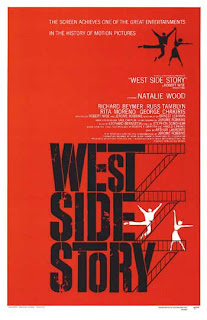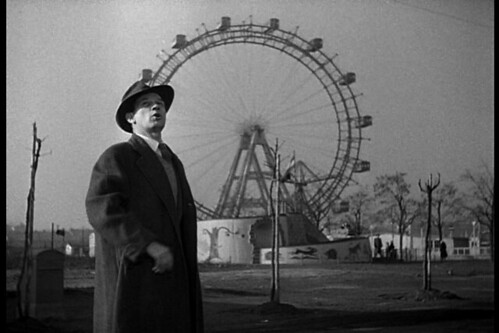They can't all be winners.
Even the strongest, smartest, most talented directors will misfire occasionally. It happens, and it's forgivable. But what about the works that lie between masterpiece and failure? The films that, far from being nonentities, are proudly second-tier? It often seems that you can learn more about a director from these films than from their best works. Sometimes in plumbing the depths of a director's filmography I'll discover a film that I either consider generally underrated or actually superior to the anointed classics. But that's not what I'm talking about here - today I'm celebrating films that, despite being far from the big leagues, are still worth your time. After all, you have to have SOMEWHERE to turn after you've seen all of the best and brightest. So here are some of my favorite second-tier films, listed by director - because "minor (name of director)" doesn't always have to be an insult.
Alfred Hitchcock
Masterpieces include: Psycho, Rear Window
But do check out: Foreign Correspondent (1940)
I've long contended that a Hitchcock film is never a waste of time. Even if it's not a classic, there will be memorable scenes, shots, and tricks from the Master of Suspense. FC takes a bit of time to get going, but its greatest strength is that you never know who you can truly trust. Joel McCrea is fine in the lead, but it's the suave support team of Herbert Marshall and George Sanders who truly shine. Hitch's keen eye for imagery also gives us visual treats like a chase through a sea of umbrellas, and a tense encounter in a windmill. It never quite coheres in the manner of, say, North by Northwest, but it's entertaining nonetheless.
John Huston
Masterpieces include: The Maltese Falcon, The Treasure of the Sierra Madre
But do check out: Key Largo (1948)
Humphrey Bogart and Edward G. Robinson face off as a hurricane traps them (and others) in a hotel. It's Bogie being Bogie and EGR being EGR, but I could watch that all day. Lauren Bacall's unique appeal is held back to "generic female" levels, but Claire Trevor steals the show as a pathetic, boozy broad (and won an Oscar for doing so). It's stagy, and not quite as tense as it perhaps should have been, but sweaty gangsters pointing guns at each other while the wind howls outside does cast a certain spell.
Michael Curtiz
Masterpieces include: Casablanca, Mildred Pierce
But do check out: Young Man with a Horn (1950)
Curtiz' output is divided into two categories: Casablanca, and all the other stuff. In picking through the "other stuff," however, I've discovered that he was one of the most talented of the studio system's journeyman directors. Even without a distinctive style, per se, the consistent quality of his films suggests more than coincidence. So while I could go on and on about, say, Four Daughters or Life With Father, I'll focus on one of his more modest successes. YMwaH stars Kirk Douglas as a troubled jazz trumpeter (based on 1920s cornetist Bix Beiderbecke), and he elevates the film from the "forgettable studio system film" gutter it might otherwise occupy. He modulates perfectly between charm and pathos, all against a great soundtrack. Lauren Bacall costars as his tempestuous wife, and Doris Day is also on hand to play a shyer, more nervous version of herself. Even though the film opts to have the protagonist reform instead of dying the early death that Beiderbecke did, it's still fairly intense in its depiction of downfall (considering the era).
Otto Preminger
Masterpieces include: Laura, Anatomy of a Murder
But do check out: The Moon Is Blue (1953)
Preminger is associated with noir and drama, not sex comedy. So it's a pleasant surprise to watch his deft handling of the latter. Known more as a curio that significantly weakened the Production Code, it's actually quite funny. The trio of William Holden, David Niven, and the otherwise unknown Maggie McNamara outwit and outflirt each other as they get into increasingly ridiculous situations. Oh, did I mention the main plot is that they're both competing to deflower her? The bad news is that it's pretty talky and starts to drag, and one can't help but wonder what it might have been like in the hands of a Hawks or McCarey. Still, it's quite amusing, with a knockout performance by McNamara as a horny ingenue (in 1953!).
Stanley Donen
Masterpieces include: Singin' in the Rain, Charade
But do check out: The Pajama Game (1957)
Donen is one of my favorite directors, a man who, like Curtiz, has a body of work riddled with hidden treasures (Two for the Road and It's Always Fair Weather, for instance). So after watching The Pajama Game, I didn't think too highly of it. But later, in describing it to someone else, I found myself saying "Yeah, it's okay except for this one part. Well, and this other part. Okay, so just these three parts. Well..." The thing is, Donen can stage a musical number better than anyone in town. Add in choreography by Bob Fosse and the numbers here are truly special, from the sultry sizzle of "Steam Heat" to the no-holds-barred insanity of "Once-a-Year Day." If the film was all song and dance, it might be truly sublime - but since it isn't, the end result is rather uneven.
Nicholas Ray
Masterpieces include: Rebel Without a Cause, In a Lonely Place
But do check out: Party Girl (1958)
My boyfriend prefaced my first viewing of Party Girl with "It's like, not that good objectively, but there's just something about it." Frustratingly vague as that is, I was forced to agree. Cyd Charisse is luminous but not exceptional, Robert Taylor is good but not memorable, and Lee J. Cobb is just straight-up hammy. Charisse's two dance numbers are bizarrely incongruous but entrancing. The plot is thin, but it all looks gorgeous. It's campy, tense, sad, and fun all at once. There's just SOMETHING about it!
Joseph L Mankiewicz
Masterpieces include: All About Eve, Julius Caesar
But do check out: Suddenly Last Summer (1959)
This somewhat campy offering is unusual fare for Mankiewicz, known for his solid studio films. On one hand you have Katharine Hepburn absolutely feasting on the scenery as a demented and delusional recluse, and on the other you have up and coming star Elizabeth Taylor giving a heartbreaking and shattering performance (with Montgomery Clift pulled between them). And let's not forget about homosexuality, cannibals, and lobotomies - oh my! It's based on a Tennessee Williams play, and it was as faithfully and competently adapted as possible considering the weirdness of the source material. It's been viewed alternately as a cult classic and just a regular classic, so watch it and decide for yourself!
Billy Wilder
Masterpieces include: Sunset Blvd, Some Like It Hot
But do check out: Irma La Douce (1963)
Does reuniting the leads from The Apartment, relocating the action to Paris and making everything ten times sillier sound like fun to you? It is! Irma lacks the sophisticated sparkle of Some Like It Hot, the dark bite of Sunset Blvd, and the pathos of The Apartment, but it does have Shirley MacLaine as the world's cutest hooker and Jack Lemmon as a suitor pretending to be different customers so he can have her to himself. The humor is broader than in Wilder's other films, which isn't a bad thing but might seem that way to those familiar with his work. Some sources claim it's the first major Hollywood film to address prostitution head-on, and consequently there's a bit of a giggly feel to it all - but you'll giggle right along with it.
Pedro Almodóvar
Masterpieces include: Talk to Her, All About My Mother
But do check out: Pepi, Luci, Bom y otras chicas del montón (1980)
It seems a bit improper to put a debut film on this list, but of the many Almodóvars I've seen, this seems to fit the bill best. Perhaps that's because it meanders amiably without getting into the more twisted stuff he became known for (although people DO pee on each other). It's good-natured anarchy that stays enjoyable, not awkward, as you watch an auteur find his voice.
Woody Allen
Masterpieces include: Annie Hall, Hannah and Her Sisters
But do check out: Everyone Says I Love You (1996)
I still can't believe that Allen has essentially cranked out a movie a year for the past four decades. When you're that prolific, you have the opportunity to touch on a variety of genres: slapstick, drama, crime, romance, mockumentary - and the musical! Despite the typical trappings like pop songs and choreography, this is hardly a traditional musical - his ensemble cast was told about the musical element only after they signed on, and he made everyone use their own singing voices, no matter how unimpressive. Viewers consequently discover that Edward Norton and Alan Alda are rather good singers and Julia Roberts is not, while navigating a feather-light plot through lovely locales (and a Groucho Marx party). Directors often trip up when working in homage, but Allen takes a relaxed enough approach here that everyone (audience included) has fun.
Joel and Ethan Coen
Masterpieces include: The Big Lebowski, No Country for Old Men
But do check out: Intolerable Cruelty (2003)
The Coens' track record is so damn near perfect that any slight fall from grace is especially glaring. I actually avoided this film for a while because of its bad reputation, but was quite surprised to find it was a perfectly charming homage to screwball comedy (if there's such a thing as cool, even-tempered screwball comedy). Perhaps it's just my low expectations talking, but George Clooney steps nicely into the archetypal Cary Grant role (what an original comparison, right?) and Catherine Zeta-Jones proves to be an effective foil. Unlike classic screwball cinema, however, the Coens have some trouble maintaining the needed level of energy and rhythm of dialogue. Yet it's a nice throwback to a genre that peaked 70+ years ago.
What are your favorite second-tier films of acclaimed directors?


























